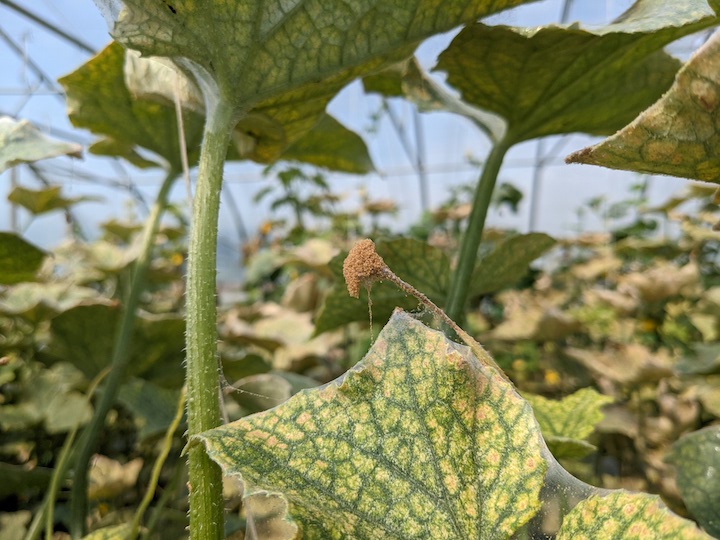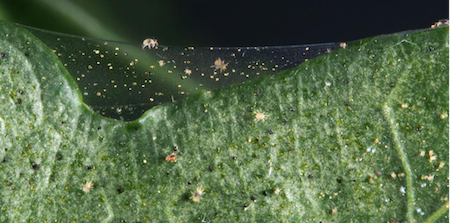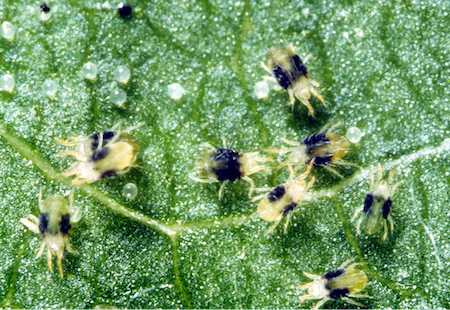
Pest: Two-spotted spider mites (Tetryanchus urticae)
Pest/disease identification and lifecycle, most common damage symptoms and crops affected:
Two-spotted spider mites are the most common mite pest of crops in the Northeast. Because they thrive in hot and dry conditions, they are commonly found in greenhouses and high tunnels. Spider mites can feed on many crops but are very attracted to eggplant, tomatoes, cucumbers, beans and cannabis. Feeding usually occurs on the underside of leaves and on tender young tissue at growth points. Feeding damage can give leaves a mottled/speckled appearance or a dull bronzed look (Fig. 1), and damage on emerging leaves at growth points can result in distorted leaves as they enlarge. When spider mite numbers are high enough they can produce a fine webbing to protect themselves, which is the origin of their common name (Fig. 1, 2). The mites themselves are tiny, only about one-fiftieth of an inch long. With good vision, individuals can be spotted with the naked eye, but it’s much easier to spot them with some magnification, such as a hand lens.

The two-spotted spider mite lifecycle can vary depending on temperature. Spider mites can live for three to four weeks, but in warmer temperatures, they can complete their lifecycle in just seven to fourteen days. Each female can lay up to 100 eggs, meaning that, especially in warmer weather, spider mite populations can grow very quickly.

Management options:
Scouting:
One difficulty in managing spider mites is that they can often go unnoticed until feeding damage symptoms on the plant are obvious, at which point the populations are often already quite large. As mentioned above, it is helpful to have a hand lens to scout proactively for spider mites. Look under younger leaves of the plant species preferred by spider mites for small yellowish mites with the characteristic two black spots on their backs (Fig. 3). Some growers choose to interplant a few individual bush bean plants among high tunnel crops to monitor spider mite populations, as beans are very attractive to them.

Cultural options:
Because spider mites do best in hot, dry and dusty conditions, frequent rains or overhead irrigation can help to suppress their numbers somewhat. However, overhead irrigation as a management strategy needs to be weighed against plant disease risks from wet foliage, and may not provide satisfactory control.
Biocontrol options:
The most common biocontrols for spider mites are the predatory mites Phytoseiulus persimilis and Neoseiulus californicus (formerly called Amblyseius californicus). These two predatory mite species live very differently, so it is important to know a little bit about them in order to select the best choice for your situation. P. persimilis reproduce fairly quickly and are voracious predators of spider mites, but they cannot survive without prey to eat. N. californicus are slower to reproduce, but because they also feed on pollen and other pests such as thrips, they can go for longer without prey so they are much better suited as a preventative control. N. californicus are also better than P. persimilis at tolerating cooler temperatures (between 50 F and 70 F) and lower humidity levels that might be found in spring greenhouses. For these reasons, growers typically use N. californicus when they first spot spider mites, or ideally before they see any as “insurance.” Growers typically use P. persimilis when spider mite populations are large or rapidly growing, or as a preventative measure at times in the summer when spider mites have shown up in the past. If spider mites get ahead of you, and you are choosing to both spray a pesticide and to order a predatory mite species for biocontrol, time your spray to allow pesticide residue to break down before the predatory mites arrive, as any pesticide material that will be effective against spider mites will also impact predatory mite species.
Much of the expense of using biological controls like these predatory mites is due to shipping costs, because mites are shipped alive and require rapid shipping. Growers may be able to save greatly on shipping if they coordinate group orders of species like N. californicus as part of a proactive spring greenhouse pest management plan.
Pesticides approved for use in certified organic production (as a last resort):
Spider mites can be impacted by some organic pesticide products (such as soaps, neem oil, horticultural oils, pyrethrin, etc.), but the most effective management approach is typically to introduce biological control organisms before spider mite populations get out of control. This is because many pesticides that work against spider mites will also reduce the populations of predators that feed on them. Predatory mite species (introduced or already present) typically reproduce more slowly than spider mites, which can lead to spider mite populations rebounding to eventually become even worse after spraying.
Please note: This information is for educational purposes. Any reference to commercial products, trade or brand names is for information only, and no endorsement or approval is intended. Pesticide registration status, approval for use in organic production and other aspects of labeling may change after the date of this writing. It is always best practice to check on a pesticide’s registration status with your state’s board of pesticide control, and for certified organic commercial producers to update their certification specialist if they are planning to use a material that is not already listed on their organic system plan. The use of any pesticide material, even those approved for use in organic production, carries risk — be sure to read and follow all label instructions. The label is the law. Pesticides labeled for home garden use are often not allowed for use in commercial production unless stated as such on the label.
Author
Written by Mariam Taleb and Caleb Goossen
Source material
“New England Vegetable Management Guide.” https://nevegetable.org/crops/insect-control-8
Schausberger, Peter, Shuichi Yano and Yukie Sato. 2021. “Cooperative Behaviors in Group-Living Spider Mites.” Frontiers in Ecology and Evolution, Vol. 9. https://www.frontiersin.org/articles/10.3389/fevo.2021.745036/full

